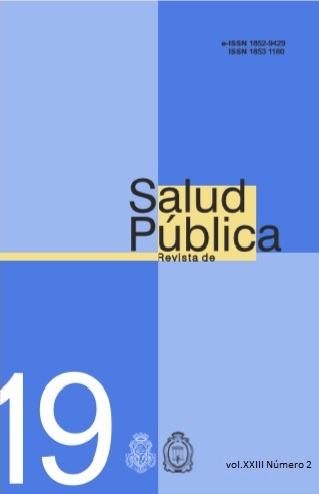PREVALENCE OF ANEMIA IN 6 TO 48 MONTH CHILDREN ATTENDING TO AN INFANCY PRIMARY CARE CENTER OF SALTO CITY.
DOI:
https://doi.org/10.31052/1853.1180.v23.n2.21185Keywords:
anemia, children aged 6 to 48 months, anemia prevalence.Abstract
Introduction. Anemia in children is a public health problem in Uruguay, being iron deficiency anemia the most frequent etiology. The anemia prevalence is higher in regions or cities different to Montevideo. However, there is no specific data from the Salto city. Objectives. Determine and compare the prevalence of anemia in children aged 6 to 48 months from two educational institutions (CAIFs) in the city of Salto and analyze the associated risk factors. Methodology. The hemoglobin levels were determined by digital puncture in 240 children of two CAIFs, the perinatal data were obtained from the child›s card and a survey to family was used to obtain ancestry data. Results The prevalence of anemia was 22.5% in the entire sample, being slightly higher in CAIF2 (27.4%) than in CAIF1 (18.4%). The frequency of anemia is significantly lower in children who had exclusive breastfeeding until 6 months of age, while the other variables analyzed were not associated with anemia. Conclusions. The prevalence of anemia observed is lower than 2011 suggesting that the policies of iron fortification of food and administration of prophylactic iron to children between 6 and 24 months has been positive. Additionally, the lower anemia frequency observed in CAIF1 than observed in CAIF2 indicates the importance of coordinated action between health services, educative institutions and society.
Downloads
References
WHO. The global prevalence of anaemia in 2011. Geneva: World Health Organization; 2015.
Worldwide prevalence of anaemia 1993-2005. Base de datos mundial sobre la anemia de la OMS, Ginebra, de Benoist B et al., eds. Organización Mundial de la Salud. 2008.
Ministerio de Salud Pública. Recomendaciones para la prevención y el tratamiento de la deficiencia de hierro. Plan Nacional de Salud Perinatal y de Primera Infancia. MSP. 2014.
WHO. Iron deficiency anaemia: assessment, prevention, and control. A guide for programme managers. Geneva, World Health Organization. 2001 (WHO/NHD/01.3).
Lozoff B, Smith JB, Kaciroti N, Clark KM, Guevara S, Jimenez E. Functional Significance of Early-Life Iron Deficiency: Outcomes at 25 Years. J Pediatr. 2013; 163(5): 1260-1266.
Pala E, Erguven M, Guven S, Erdogan M, Balta T. Psychomotor development in children with iron deficiency and iron-deficiency anemia. Food Nutr Bull. 2010; 31(3):431-5.
Thorisdottir AV, Gunnarsdottir I, Palsson GI, Gretarsson SJ, Thorsdottir I. Iron status and developmental scores in 6-year-olds highlights ongoing need to tackle iron deficiency in infants. Acta Paediatr. 2013; 102(9):914-9.
Illa. M, Moll. MJ, García. AM, Satriano. R, Ferreira. R, Estefanell. C, Sayagués. B. Estudio de la frecuencia y magnitud del déficit de hierro en niños de 6 a 24 meses de edad, usuarios de los servicios del Ministerio de Salud Pública. Arch. Pediatr. Urug 2008; 79(1): 21-31.
Bove. MI, Cerruti. F. Encuesta nacional sobre estado nutricional, prácticas de alimentación y anemia. Montevideo: MSP, MIDES, UNICEF, RUANI; 2011.
Machado K, Alcarraz G, Morinico E, Briozzo T, Gutierrez S. Anemia ferropénica en niños menores de un año usuarios de CASMU-IAMPP: prevalencia y factores asociados. Arch. Pediat. Urug. 2017; 88(5): 254-260.
Organización Mundial de la Salud. Concentraciones de hemoglobina para diagnosticar la anemia y evaluar su gravedad. Ginebra, Organización Mundial de la Salud. 2011 (WHO/NMH/NHD/MNM/11.1)
Organización Mundial de la Salud. Iron defieciency anaemia: assesmment, prevention and control. A guide for programme managers. 2001. WHO/NHD/01.3
Ministerio de Salud Pública. Guías para la prevención de la deficiencia de hierro. Programa Nacional de Nutrición, 2008. Disponible en: http://www.msp.gub.uy/uc_1972_1. html
Pinasco, P., Fernández, M y Rodríguez, MJ. 2016. Prevalencia de anemia en lactantes de 8 meses afiliados al Centro de Asistencia Médica de Salto en el período 1de setiembre de 2015 al 30 de marzo de 2016. 5tas Jornadas de Pediatría del Litoral. 4 y 5 de noviembre de 2016. Paysandú.
Cabella, W., Nathan, M., y Tenenbaum, M. (2013). “Situación de la población afrodescendiente”. En: Calvo, J.J. (comp.). Atlas sociodemográfico y de la desigualdad del Uruguay. Las Necesidades Básicas Insatisfechas a partir de los Censos 2011, INE, UDELAR, MIDES, UNFPA y CSP-OPP. Montevideo: Trilce. ISBN 978-9974-32-616-3.
da Luz J, Avila A, Icasuriaga S, Góngora M, Castillo L, Serrón A, Kimura EM, Costa FF, Sans M, y Sonati MF. Frequency and spectrum of hemoglobinopathy mutations in a paediatric population of Uruguay. Genet. Mol. Biol. 2013; 36(3): 316-22
da Luz JA, Sans M, Kimura EM, Albuquerque DM, Sonati MF y Costa FF. alpha-thalassemia, HbS, and beta-globin gene cluster haplotypes in two Afro-Uruguayan sub-populations from northern and southern Uruguay. Genet. Mol. Biol. 2006; 29(4): 595-600.
Downloads
Published
How to Cite
Issue
Section
License
Copyright (c) 2019 Escuela de Salud Pública y Ambiente. Facultad de Ciencias Médicas. Universidad Nacional de Córdoba

This work is licensed under a Creative Commons Attribution-NonCommercial 4.0 International License.
Authors who publish with this journal agree to the following terms:
- Authors retain copyright and grant the journal right of first publication with the work simultaneously licensed under a Creative Commons Attribution License which allows the work to be copied, distributed, exhibited and interpreted as long as it is not done for commercial purposes.
- Authors are able to enter into separate, additional contractual arrangements for the non-exclusive distribution of the journal's published version of the work (e.g., post it to an institutional repository or publish it in a book), with an acknowledgement of its initial publication in this journal.
- Authors are permitted and encouraged to post their work online (e.g., in institutional repositories or on their website) after the publication process. (See The Effect of Open Access). (See The Effect of Open Access).



